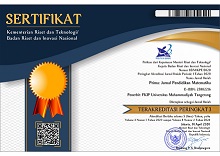ANALYSIS OF STUDENTS' CREATIVE THINKING SKILLS IN LINEAR ALGEBRA COURSES DURING THE COVID-19 PANDEMIC
Abstract
Keywords
Full Text:
PDFReferences
Andiyana, M. A., Maya, R., & Hidayat, W. (2018). ANALISIS KEMAMPUAN BERPIKIR KREATIF MATEMATIS SISWA SMP PADA MATERI BANGUN RUANG. JPMI (Jurnal Pembelajaran Matematika Inovatif), 1(3), 239–248. https://doi.org/10.22460/jpmi.v1i3.p239-248
Bao, W. (2020). COVID ‐19 and online teaching in higher education: A case study of Peking University . Human Behavior and Emerging Technologies. https://doi.org/10.1002/hbe2.191
Cheema, J. R. (2013). Does it matter how you measure it? the case of self-efficacy in mathematics. Issues in Educational Research.
Chita, A., Harahap, P., & Harahap, S. R. (2020). Covid 19: Self Regulated Learning Mahasiswa. Al-Irsyad: Jurnal Pendidikan Dan Konseling.
Creswell, J. W., & Creswell, J. D. (2018). Research and Design Qualitative, Quantitative and Mixed Methods Approaches. In Thousand Oaks California.
Dai, D., & Lin, G. (2020). Online Home Study Plan for Postponed 2020 Spring Semester during the COVID-19 Epidemic: A Case Study of Tangquan Middle School in Nanjing, Jiangsu Province, China. SSRN Electronic Journal. https://doi.org/10.2139/ssrn.3555539
Dewi, W. A. F. (2020). Dampak COVID-19 terhadap Implementasi PembelajaDewi, W. A. F. (2020). Dampak COVID-19 terhadap Implementasi Pembelajaran Daring di Sekolah Dasar. EDUKATIF : JURNAL ILMU PENDIDIKAN. https://doi.org/10.31004/edukatif.v2i1.89ran Daring di Sekolah Dasar. EDUKATIF : JURNAL ILMU PENDIDIKAN.
Dilla, S. C., Hidayat, W., & Rohaeti, E. E. (2018). Faktor Gender dan Resiliensi dalam Pencapaian Kemampuan Berpikir Kreatif Matematis Siswa SMA. Journal of Medives : Journal of Mathematics Education IKIP Veteran Semarang, 2(1), 129–136. https://doi.org/10.31331/medives.v2i1.553
Fadillah, A., Nopitasari, D., & Pradja, B. P. (2020). Blended Learning Model During the Covid-19 Pandemic: Analysis of Student’s’ Mathematical Disposition. JTAM (Jurnal Teori Dan Aplikasi Matematika), 4(2), 173–181. https://doi.org/10.31764/jtam.v4i2.2582
Fadillah, A., Sukmawati, R., & Rahardjo, S. (2021). AKSIOMA: Jurnal Program Studi Pendidikan Matematika 1206| ANALYSIS OF STUDENT DIGITAL LITERACY IN LINEAR ALGEBRA COURSES DURING THE COVID-19 PANDEMIC. 10(2), 1206–1212. https://doi.org/10.24127/ajpm.v10i2.3704
Febrianti, Y., Djahir, Y., & Fatimah, S. (2016). Analisis Kemampuan Berpikir Kreatif Peserta Didik dengan Memanfaatkan Lingkungan pada Mata Pelajaran Ekonomi di SMA Negeri 6 Palembang. Jurnal Profit, 3(1), 121–127. http;//ejournal.unsri.ac.id/index.php/jp/issue/view/591
Firdaus, H. M., Widodo, A., & Rochintaniawati, D. (2018). Analisis Kemampuan Berpikir Kreatif dan Proses Pengembangan Kemampuan Berpikir Kreatif Siswa SMP pada Pembelajaran Biologi. Assimilation: Indonesian Journal of Biology Education, 1(1), 21–28. https://doi.org/10.17509/aijbe.v1i1.11452
Firman, F., & Rahayu, S. (2020). Pembelajaran Online di Tengah Pandemi Covid-19. Indonesian Journal of Educational Science (IJES). https://doi.org/10.31605/ijes.v2i2.659
Goldschmidt, K. (2020). The COVID-19 Pandemic: Technology use to Support the Wellbeing of Children. Journal of Pediatric Nursing, 53, 88–90. https://doi.org/10.1016/j.pedn.2020.04.013
Hidayat, P. W., & Widjajanti, D. B. (2018). Analisis kemampuan berpikir kreatif dan minat belajar siswa dalam mengerjakan soal open ended dengan pendekatan CTL. Pythagoras: Jurnal Pendidikan Matematika, 13(1), 63–75. https://doi.org/10.21831/pg.v13i1.21167
Moleong, L. J. (2019). Metodologi Penelitian Kualitatif (Edisi Revisi). PT. Remaja Rosda Karya. https://doi.org/10.1016/j.carbpol.2013.02.055
Mulenga, E. M., & Marbán, J. M. (2020). Is COVID-19 the Gateway for Digital Learning in Mathematics Education? Contemporary Educational Technology, 12(2), 1–11. https://doi.org/10.30935/cedtech/7949
Perienen, A. (2020). Frameworks for ICT Integration in Mathematics Education - A Teacher’s Perspective. Eurasia Journal of Mathematics, Science and Technology Education. https://doi.org/10.29333/ejmste/7803
Sadikin, A., & Hamidah, A. (2020). Pembelajaran Daring di Tengah Wabah Covid-19. Biosilico. https://doi.org/10.22437/bio.v6i2.9759
Sari, I. M., Sumiati, E., & Siahaan, P. (2013). ANALISIS KEMAMPUAN BERPIKIR KREATIF SISWA SMP DALAM PEMBELAJARAN PENDIDIKAN TEKNOLOGI DASAR (PTD). Jurnal Pengajaran Matematika Dan Ilmu Pengetahuan Alam, 18(1), 60–68. https://doi.org/10.18269/jpmipa.v18i1.258
Sugiyono. (2015). Metode Penelitian. Metode Penelitian.
DOI: http://dx.doi.org/10.31000/prima.v6i1.5266
Article Metrics
Abstract - 959 PDF - 953Refbacks
- There are currently no refbacks.
Prima: Jurnal Pendidikan Matematika
Program Studi Pendidikan Matematika
Fakultas Keguruan dan Ilmu Pendidikan
Universitas Muhammadiyah Tangerang
Jl. Perintis Kemerdekaan I/33, Cikokol
Kota Tangerang, Indonesia
e-mail: primajpm@gmail.com
Prima: Jurnal Pendidikan Matematika (p-ISSN: 2579-9827 | e-ISSN: 2580-2216) is licensed under a Creative Commons Attribution 4.0 International License.







